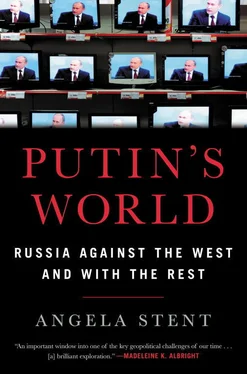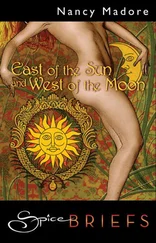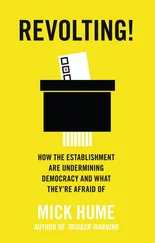Despite all of these tensions, the EU has remained united over the imposition of sanctions on Russia. In 2014, the EU was Russia’s largest trading partner, constituting 48 percent of Russia’s foreign trade. EU exports are mainly of machinery, electronic goods, and food. Russia, on the other hand, accounted for 8 percent of total EU trade, and 82 percent of its exports are fossil fuels. Germany was Russia’s largest trade partner within the EU, followed by the Netherlands. The EU is by far the largest investor in Russia. 16After Russia’s invasion of Crimea, the EU introduced a number of diplomatic measures, pushing Russia out of the G-8 (making the group once again the G-7), suspending its negotiations to join the Organization for Economic Co-operation and Development and the International Energy Agency, and cancelling its regular summits. It issued visa bans and asset freezes to a total of 151 people and prohibited most imports originating in Crimea and investments in Crimea.
Following the downing of MH-17, when the EU joined US financial sanctions against Russia, it forbade loans to five major Russian state-owned banks and the export of dual-use technology. It also joined the US ban on export of energy-related technology to be used in Arctic oil exploration and production. The Russians’ counter-sanctions banned what amounted to 43 percent of EU agri-food exports to Russia and 4.2 percent of worldwide EU agri-food exports. Although the overall percentage numbers are small, the impact on individual sectors and countries has been disproportionately large. Whereas EU’s financial sanctions have had a significant impact on the Russian economy, the counter-sanctions have stimulated domestic Russian agricultural production while they have adversely impacted Poland and the Baltic states. 17China has now replaced the EU as Russia’s largest trading partner.
As time wore on, EU unity in support of sanctions began to wane. The economies of member countries experienced different degrees of economic challenges, and the business communities in many EU countries began to lobby their governments to rethink the utility of sanctions. After all, Russia remained entrenched in Crimea and continued to support the separatists in the Donbas region. Despite the economic difficulties caused by the sanctions, not only has the Kremlin not modified its policy in Ukraine; it has also scapegoated the West for the Russian population’s economic hardships while rallying them to the patriotic flag of resisting pressure and beating the sanctions. Putin clearly hoped that Western support for sanctions would wane and that the EU would eventually want to get back to business with Russia, and would blame the United States—for whom economic ties to Russia were far less important—for forcing it to suffer economically. Criticism from a number of EU members has raised serious doubt about how long the sanctions regime will last, but so far it has, partly due to inertia and the continuing support of the EU’s major players, Germany and France.
THE KREMLIN AND THE EUROSKEPTICS
Because EU unity on sanctions has increasingly irked Moscow, it is not surprising that Russia has supported any movement that might weaken that unity. Moreover, Putin has elevated the EU as a potential threat to Russia’s ability to preserve its sphere of influence in their shared neighborhood. The growing number of groups in Europe on the Right and the Left that dislike the European Union and would like their countries to leave it have generally met with Kremlin approval.
Criticisms of the EU are wide-ranging. There is anger at what people see as unfair subsidization of poorer countries by richer ones. There is opposition to “faceless Brussels bureaucrats” imposing excessive regulation on them, including forcing them to take in migrants from the Middle East and Africa. What unites these groups is anger at the loss of national sovereignty and self-determination to a supranational bureaucracy—as well as thinly disguised racism. They also share characteristics with the identity politics of those Americans who elected Donald Trump, yearning for an imagined past when their country was more ethnically homogeneous and independent. The cry “Take our country back again” resonates with all of these groups.
Since sovereignty is such a key part of Putin’s ideology, there is a natural affinity between the Kremlin and these groups. They formed their own voting bloc in the European parliament in June 2015: Europe of Nations and Freedom (ENF). The irony of Euroskeptical parties banding together in the most symbolic of EU institutions—the European Parliament in Strasbourg—was apparently not lost on Moscow. The major parties in this bloc are the French National Front, led by Marine Le Pen; Geert Wilders’s Dutch Party for Freedom; and the British UK Independence Party (UKIP). They account for about 5 percent of members of the European Parliament (MEPs), but because of the way votes are apportioned, as many as 20 percent of MEPs can vote in favor of Kremlin-friendly positions. This group—sometimes supported by Far Left pro-Russia parties—has voted against sanctions on Russia and against assistance for Ukraine. 18
Russian support for Far Right European parties is difficult to document in full, but it is known that the French National Front has received loans from Russian banks. In 2014, it confirmed receiving a $10 million loan from Russia. 19In February 2016, its leader, Marine Le Pen, asked Russia for a 28 million loan. 20There are rumors of Russian support of other groups, including UKIP, which led the successful move to have Britain leave the EU. One prominent Brexit supporter met multiple times with the Russian ambassador to the UK. 21Putin repeatedly denied that he was in favor of Brexit, but Russian comments after the vote would suggest the opposite. 22Shortly after her election as the new UKIP head, Diane James said that Vladimir Putin was a great leader, “up there with Winston Churchill and Margaret Thatcher.” 23It sounds like a mutual admiration society.
Beyond support for Euroskeptical movements, Russia has organized conferences for nationalist groups and for a motley collection of separatists. In 2015, it hosted the first International Russian Conservative Forum in Saint Petersburg, attended by Far Right nationalist, neo-Nazi, and anti-Semitic groups, who regard themselves as marginalized by the European mainstream. For them the “fascist” enemy is in Ukraine. 24Later that year, the Russian government helped fund a conference in Moscow that brought together separatists from Eastern Ukraine, Europe, and even the United States. 25The “Dialogue of nations: the right to self-determination and the construction of a multipolar world” included representatives of a collection of fringe groups who denounced the US and Europe for the Ukrainian and refugee crises but had not a word to say about Russia’s role in these events. 26Ironically, the Kremlin is encouraging these groups even though Russia itself fought two bloody wars with Chechnya and defeated a separatist movement on its own territory.
“NEW” EUROPE’S CHANGING VIEW OF RUSSIA
One of the more notable surprises of the past few years—at least for those in the West—is the extent to which some countries in Central Europe have become much more favorably inclined toward the Kremlin. After all, when Germany united and communism fell in Central and Eastern Europe, the former members of the Warsaw Pact could not wait to join the West. Forty years of Soviet domination had left them deeply suspicious of Russia’s intentions even after the USSR collapsed. They hastened to embrace the West to preclude a renewed embrace by Moscow. Their first order of business was to develop ties with NATO. Poland, the Czech Republic, and Hungary eventually joined the organization in 1999, and Bulgaria, Romania, Slovakia, Slovenia, and the Baltic states joined in 2004. Most also joined the EU in 2004, with Bulgaria and Romania following in 2007.
Читать дальше












